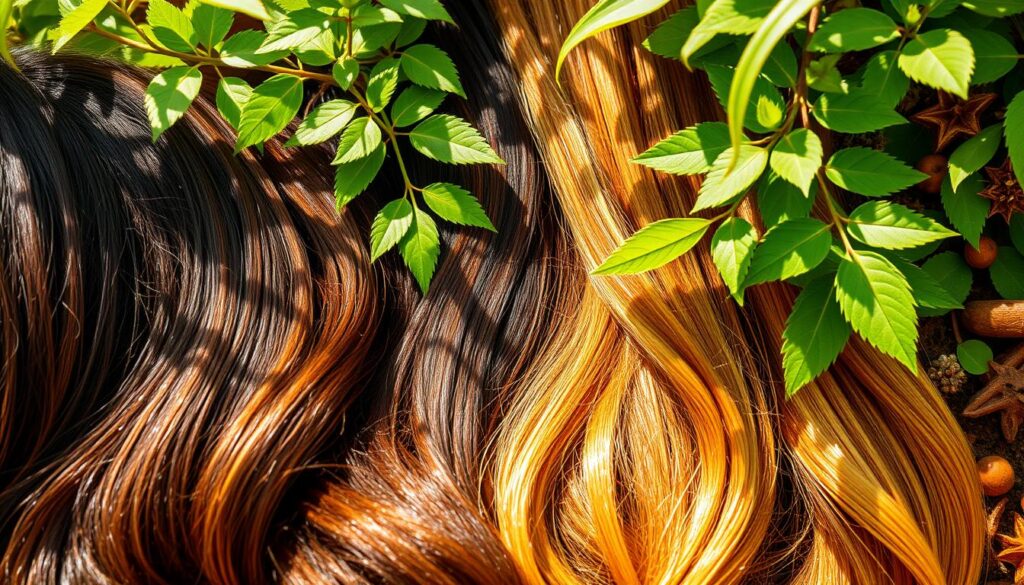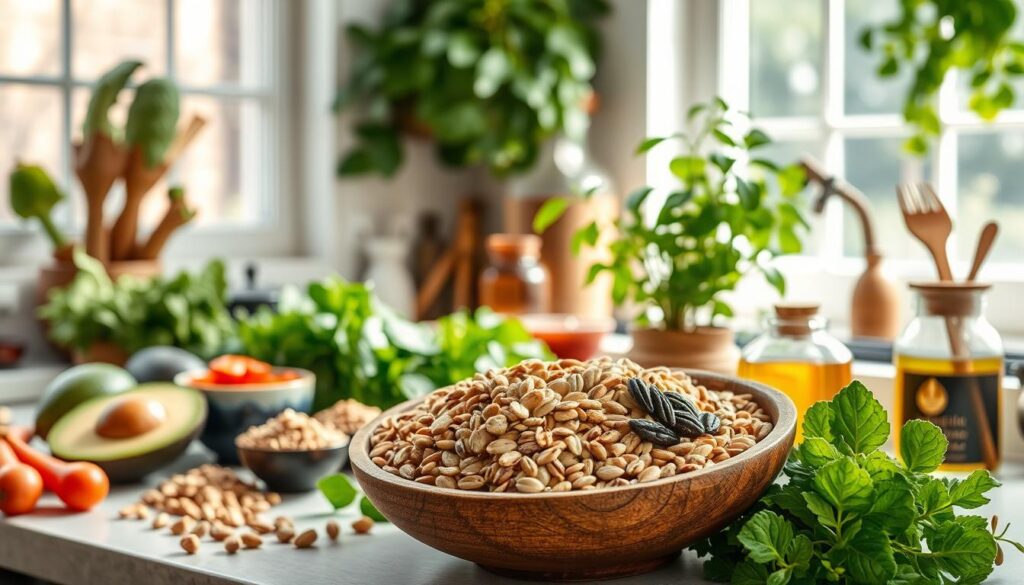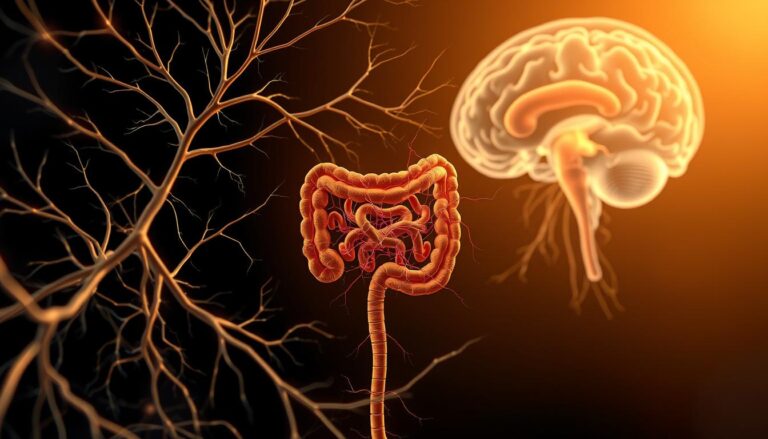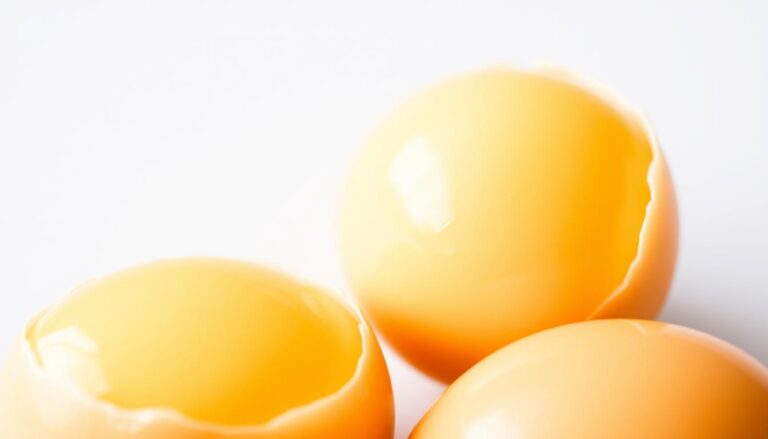Are you tired of your hair turning gray and dull? This might be because of less melanin the pigment that gives hair color.
But there are natural ways to boost melanin and make your hair look young again. We’ll look into how melanin works in hair and find ways to keep it healthy and vibrant.
Key Takeaways
- Melanin is the pigment that determines hair color produced by melanocyte cells in the hair follicles.
- As we age, melanin production decreases leading to gray hair with a 10-20% decrease per decade after age 30.
- Factors like stress oxidative stress and nutritional deficiencies can accelerate the depletion of melanocytes and melanin.
- Natural methods like a melanin-boosting diet herbal remedies, and topical treatments can help maintain hair pigmentation.
- Lifestyle modifications and professional guidance can further support healthy melanin levels in the hair.
What is Melanin and Its Role in Hair Color?
Melanin is the pigment that gives color to our hair eyes, and skin. It is made by cells called melanocytes in the hair follicles. There are two main types eumelanin and pheomelanin.
Eumelanin makes hair shades of black and brown. Pheomelanin creates red and strawberry blonde colors. The mix of these melanins decides our natural hair color.
- Eumelanin is key for dark colors in hair eyes, and skin like brown and black.
- Pheomelanin gives pinkish colors and is behind red and strawberry blonde hair.
- Neuromelanin a third type affects neuron colors but not physical appearance.
The amount and how these melanins are spread in hair follicles define hair colors. This range includes everything from flaxen blond to coal black.
More than 90% of people in the world are estimated to have brown or black hair due to a high amount of eumelanin.
Genes like MC1R, ASIP, and KITLG affect melanin production. This leads to many hair color variations. As we get older less melanin means our hair looks gray.
Hair Graying Understanding the Process
Hair graying is a natural part of aging. It happens because melanin production slows down. Melanin is the pigment that gives hair its color. As we age, melanocytes the cells that make melanin, work less. This leads to gray or white hair.
Starting at 30, melanin levels drop by 10-20% each decade. By 50 half of people have at least 50% gray hair. This is because melanocytes decrease in number and activity, reducing hair pigmentation.
The Role of Genetics and Environmental Factors
Genetics greatly influence hair graying. Some people may start graying early while others keep their hair color longer. Environmental factors like UV rays stress, and nutrient deficiencies can also speed up graying.
- Genetics Premature gray hair can be inherited, with some individuals experiencing graying as early as their 20s or 30s.
- Sun exposure UV rays from sunlight can damage melanocytes leading to a reduction in melanin production and premature graying.
- Stress Chronic stress can take a toll on the body impacting the melanocytes and contributing to hair graying.
- Nutrient deficiencies: Lack of essential vitamins and minerals, such as vitamin B12, can disrupt melanin synthesis and promote premature graying.
Knowing why hair grays can help people manage aging better. It can also help them find ways to keep their hair color longer.
Embracing the change of going gray can positively impact one’s aging trajectory.
Oxidative Stress and Hair Graying
Premature hair graying worries many people. It’s often caused by oxidative stress. UV rays, pollution, and too many free radicals harm melanocytes. These cells make melanin, the pigment that colors hair.
Melanin gives hair its color, from black to blonde. When melanocytes don’t work right, melanin production drops. This makes hair look gray or white too soon.
The Role of Oxidative Stress in Hair Graying
Oxidative stress happens when free radicals outnumber the body’s defenses. These harmful molecules damage cells, including melanocytes. This damage leads to less melanin and gray hair.
Things like UV exposure, pollution, and smoking increase free radicals. This speeds up graying. Also not enough vitamin B12 and vitamin D can cause early graying. These vitamins help melanocytes work well.
Oxidative stress is indicated to be an underlying factor in hair graying affecting human hair follicles directly.
To fight hair graying, try different approaches. Eat foods rich in antioxidants, like berries leafy greens, and citrus fruits. They help melanin production. Also herbal remedies and supplements, like catalase and superoxide dismutase, can boost melanin and slow graying.
Understanding oxidative stress’s role in graying is key. By taking action you can keep your hair color longer and delay graying.
How can I increase melanin in my hair?
Graying hair is a natural part of aging. Yet there are ways to boost melanin and keep your hair color bright. Eating foods rich in melanin using herbal remedies, and making lifestyle changes can help. These steps can slow down graying and keep your hair color looking great.
Dietary Approach: Melanin-Boosting Foods
Eating foods full of antioxidants vitamins, and minerals helps melanin production. Eat berries, leafy greens nuts seeds citrus fruits, and dark chocolate to nourish your hair and skin.
- Vitamin A found in fish, leafy greens, and carrots protects skin and hair.
- Vitamin E in vegetable oils nuts, and seeds, fights UV damage.
- Vitamin C in peppers kiwi and broccoli reduces pigmentation and boosts melanin.
- Vitamin B12 helps increase melanin, especially in those with vitiligo.
Herbal Remedies and Supplements
Some herbs and supplements can also boost melanin and fight graying. Amla bhringraj, and ashwagandha are herbs known for healthy hair pigmentation. Catalase and superoxide dismutase supplements may also help keep melanin levels up and slow graying.
Melanin production slows or stops due to various reasons, including medical conditions like vitiligo and normal aging processes. However research is ongoing about the effectiveness of supplements in increasing melanin production while a balanced diet with antioxidant-rich foods is recommended for healthy skin nails, and hair.

While these methods can’t stop or reverse gray hair completely, they can slow it down. By using a holistic approach, you can support melanin production and keep your hair’s natural color.
Dietary Approach: Melanin-Boosting Foods
Eating the right foods can boost melanin in your hair. Foods rich in antioxidants, copper, and vitamin C help melanin production. They also protect melanocytes from damage. Adding these foods to your meals can keep melanin levels healthy and slow gray hair.
Berries
Berries like blueberries, blackberries, and raspberries are full of antioxidants. They also have a lot of vitamin C, which is key for melanin. These colorful fruits are great for your hair.
Nuts and Seeds
Nuts and seeds, such as walnuts, almonds, and pumpkin seeds, are high in copper. Copper is important for melanin. Eating these can help your hair stay pigmented.
Leafy Greens
Leafy greens like spinach, kale, and Swiss chard are full of antioxidants. They also have vitamins and minerals that boost melanin. These greens are essential for a melanin-boosting diet.
Citrus Fruits
Citrus fruits, including oranges, lemons, and grapefruits, are rich in vitamin C. Vitamin C is vital for melanin. Adding these fruits to your meals can help your hair’s color.
By eating these melanin-boosting foods, you can keep your hair color healthy. This can also delay gray hair.
Herbal Remedies and Supplements
Changing your diet is just one way to boost melanin and fight gray hair. Herbs like amla, bhringraj, and ashwagandha have been used for ages to keep hair color vibrant.
Supplements like catalase and superoxide dismutase also help by fighting off damage to melanin-producing cells. Adding these natural helpers to your hair care can support your diet in keeping your hair looking young and full of color.
Melanin Boosting Herbs
- Amla: Known as Indian gooseberry amla is packed with vitamin C and antioxidants. It may boost melanin production and fight hair graying.
- Bhringraj This Ayurvedic herb is known for its anti graying effects. It may revitalize the cells that color your hair.
- Ashwagandha This adaptogenic herb is believed to positively affect melanin production. It may also help counteract stress, which can cause early hair graying.
Antioxidant Supplements
Supplements like catalase and superoxide dismutase are enzymes that protect melanocytes from damage. This damage is a major cause of hair graying. By keeping these cells healthy these supplements may help keep your hair color vibrant for longer.
| Supplement | Potential Benefits |
|---|---|
| Catalase | Protects melanocytes from oxidative damage, helping to preserve melanin production |
| Superoxide Dismutase | Neutralizes free radicals and reduces oxidative stress, supporting hair pigmentation |
Incorporating natural herbs and antioxidant supplements into your hair care routine can be a powerful way to boost melanin production and protect against premature graying.
Topical Treatments Essential Oils and Natural Ingredients
Topical treatments with essential oils and natural ingredients can help with melanin production in hair. These treatments work with what you eat and take as supplements. They help keep your hair color healthy and vibrant.
Some key ingredients to look for in topical hair treatments include:
- Rosemary oil Stimulates melanocyte activity to promote melanin production.
- Peppermint oil Increases blood circulation to the scalp which can enhance melanin synthesis.
- Saw palmetto oil Contains compounds that may help regulate melanin levels.
- Antioxidants like vitamin C, vitamin E and CoQ10 Protect against oxidative stress that can deplete melanin.
Using these natural treatments on your scalp and hair can help with graying. It’s a good way to support your hair’s natural color. When you use them with a diet and supplements that boost melanin your hair can stay young and vibrant.
| Natural Ingredient | Key Benefits for Hair Pigmentation |
|---|---|
| Rosemary Oil | Stimulates melanocyte activity to promote melanin production |
| Peppermint Oil | Increases blood circulation to the scalp, enhancing melanin synthesis |
| Saw Palmetto Oil | Contains compounds that may help regulate melanin levels |
| Vitamin C, Vitamin E, CoQ10 | Antioxidants that protect against oxidative stress and melanin depletion |
Topical treatments with essential oils and natural ingredients can work in harmony with dietary and supplemental approaches to maintain healthy hair color and prevent premature graying.
Lifestyle Modifications
Making lifestyle changes can help with melanin production and slow graying. Reducing stress getting enough sleep and exercising regularly support melanocyte health. These changes help fight oxidative stress and inflammation boosting hair pigmentation.
Stress Management
Chronic stress can harm the body’s balance, leading to hair graying. Activities like meditation, yoga or deep breathing can reduce stress. They help support melanin production.
Adequate Sleep
Quality sleep is key for hair follicle health. Lack of sleep causes oxidative stress and inflammation, hurting melanin synthesis. Aim for 7-9 hours of sleep each night.
Regular Exercise
Exercise boosts melanin levels and hair color. It improves blood flow delivering nutrients to hair follicles. Mix cardio, strength training, and flexibility exercises for a healthy lifestyle.
| Lifestyle Change | Benefits for Hair Pigmentation |
|---|---|
| Stress Management | Reduces oxidative stress and inflammation, supporting melanin production |
| Adequate Sleep | Promotes overall hair health and melanin synthesis |
| Regular Exercise | Improves blood circulation and nutrient delivery to hair follicles |
Adding these lifestyle changes to your routine helps maintain hair pigmentation. It slows down graying.

Read more: Foods That Stop Grey Hair
Incorporating simple lifestyle adjustments like stress management, quality sleep, and regular exercise can have a profound impact on the health and appearance of your hair.
Professional Guidance and Personalization
Boosting melanin and fighting gray hair often requires a personalized approach. Getting advice from hair care experts is crucial. They help create a treatment plan that fits your hair and scalp perfectly.
A professional consultation starts with a detailed hair analysis. This checks your diet, lifestyle, hormones, and any nutritional gaps. These factors can affect melanin production.
After the analysis, a personalized treatment plan is made. It might include diet changes, supplements topical treatments and lifestyle tweaks. This method tackles the real causes of gray hair, not just the symptoms.
Studies show that fixing vitamin D levels iron, and stress can help keep hair color. A trichologist can craft a plan to bring back your natural hair color.
Consistency and patience are key factors for successful outcomes when it comes to boosting melanin and delaying gray hair. A personalized, holistic treatment plan is essential for addressing the underlying causes.
Working with hair care experts ensures your needs are met. They use the best strategies to help you reach your hair goals.
Conclusion
Gray hair is a natural part of aging but there are ways to keep your hair looking vibrant. Eating foods rich in melanin and using herbal remedies can help. Topical treatments and lifestyle changes also play a role in slowing down graying.
Working with hair care experts can make these methods even more effective. This way, you can enjoy your hair’s natural color for longer. It’s all about taking care of your hair and embracing gray hair as a natural part of aging.
By using natural methods, you can control your hair’s color. Protecting your hair from damage and using melanin-boosting foods are key. Getting advice from hair care professionals can also help you find the best solutions for your hair.
Following these steps can keep your hair looking young and vibrant. You’ll enjoy a healthy glowing mane for years to come. So start taking care of your hair today and enjoy the beauty of gray hair.





